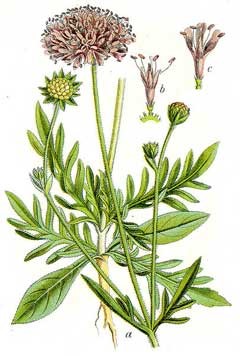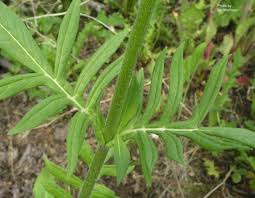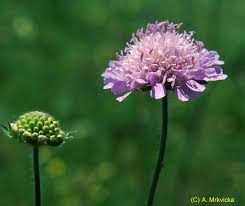Field Scabious (Knautia arvensis)- November 2014
Download this weed post on field scabious as a PDF
Identification

Field scabious, also known as blue buttons, is a perennial forb in the Dipsacaceae (Teasel) family. It usually grows 2 to 4 feet tall and has a woody, branched taproot. Leaves and stems are covered in stiff hairs. The deeply divided leaves decrease in size as you move toward the flowering shoot, and the flowers are borne on leafless stalks. Solitary flowers, sometimes described as looking similar in shape to red clover flowers, are violet blue to pale purple. At the base of the flower are 8 to 12 sepals and a ring of narrow, green bracts.
Impacts
The impacts of field scabious are not well-documented. However, it has been described as being difficult to eradicate once it is established. There are also reports that this species may escape cultivation and become abundant in waste areas, roadsides, and forage or hay fields, and that it can decrease hay and forage production. Cattle will eat field scabious early in the season, but it is not palatable once flowering begins. In its native range, field scabious is an important floral resource for pollinators, and it is sold outside its native range as a showy ornamental and for its attractiveness to butterflies and bees. It is also used medicinally for sore throat and coughs and for certain skin conditions such as eczema because it has a drying effect on skin.
Habitat

Photo by Ian Morrison, XID Services.
Field scabious is native throughout Europe with the exception of the extreme northern portion of the continent. Its introduction to North America was likely as an escaped ornamental. It is currently reported in all the southern tier Canadian provinces and most northern U.S. states where it tends to invade pastures, roadsides, and waste areas. It generally prefers loose, loamy soils that are nutrient rich and moderately moist to dry. It was first reported in Montana in Gallatin County in 1932.
Spread
Field scabious reproduces only by seed. It is a prolific seed producer, with each plant capable of producing up to 2,000 seeds, and the seed bank is reported to be persistent.
Management priorities

Photo by A. Mrkvicka.
In Montana field scabious is listed as a noxious weed in five counties, all in the southwestern portion of the state. Although listed as a noxious weed in the Canadian provinces of Alberta, British Columbia, and Saskatchewan, field scabious is not a state-listed noxious weed anywhere in the U.S. Field scabious control can be achieved using cultural and mechanical methods, as well as herbicide applications. Because of its seed production and long-lived seed bank, one important management strategy is to prevent the flowers from setting seed. This can be accomplished by mowing or cultivation before seeds set. Hand-pulling or digging is difficult due to the substantial taproot. Field scabious is listed on a number of herbicide labels, and products containing metsulfuron methyl (e.g. Escort, Cimarron) are reported to provide excellent control if applied at the appropriate time and with a surfactant. There are no biological control agents available for field scabious. As with many unwanted plants, establishing or maintaining desirable vegetation may be an important component of managing this species, as a healthy perennial plant community will have less bare ground where new species can establish.
